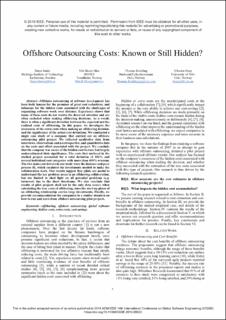| dc.contributor.author | Šmite, Darja | |
| dc.contributor.author | Moe, Nils Brede | |
| dc.contributor.author | Krekling, Thomas | |
| dc.contributor.author | Stray, Viktoria | |
| dc.date.accessioned | 2022-05-05T08:30:45Z | |
| dc.date.available | 2022-05-05T08:30:45Z | |
| dc.date.created | 2020-01-17T00:41:17Z | |
| dc.date.issued | 2019 | |
| dc.identifier.citation | 2019 ACM/IEEE 14th International Conference on Global Software Engineering (ICGSE). | en_US |
| dc.identifier.isbn | 9781538692127 | |
| dc.identifier.uri | https://hdl.handle.net/11250/2994306 | |
| dc.description.abstract | Offshore outsourcing of software development has been both famous for the promises of great cost reductions, and infamous for the hidden costs associated with the challenges of organizing software work over distance. Experience shows that many of these costs do not receive the deserved attention and are often excluded when making offshoring decisions. As a result, there is often a significant deviation between the expected and the realized costs of offshoring. In this paper, we investigate the awareness of the extra costs when making an offshoring decision, and the significance of the actual cost deviations. We conducted a single case study of a company that carried out an offshore outsourcing pilot project. We collected qualitative data from interviews, observations and a retrospective, and quantitative data on the costs and effort associated with the project. We conclude that the company was aware of the hidden cost factors, but largely underestimated their significance. The costs that surfaced in the studied project accounted for a total deviation of 181% and several individual cost categories with more than 400% overrun. The two main cost drivers in our study were the distance and poor process fit, which escalated the investments needed to make the collaboration work. Our results suggest that pilots are useful to understand the key problem areas in an offshoring collaboration, but too limited to shed light on all potential problems (e.g. turnover) due to the short timeframe. We also conclude that results of pilot projects shall not be the only data source when calculating the true costs of offshoring, since the start-up phase of an offshoring relationship carries large investments. Finally, we provide recommendations for companies in a similar situation on how to run and learn from offshore outsourcing pilot projects. | en_US |
| dc.language.iso | eng | en_US |
| dc.publisher | Institute of Electrical and Electronics Engineers (IEEE) | en_US |
| dc.relation.ispartof | 2019 ACM/IEEE 14th International Conference on Global Software Engineering (ICGSE) | |
| dc.subject | Offshoring | en_US |
| dc.subject | Offshore outsourcing | en_US |
| dc.subject | Global software engineering | en_US |
| dc.subject | Hidden costs | en_US |
| dc.subject | Extra costs | en_US |
| dc.subject | Cost-savings | en_US |
| dc.title | Offshore outsourcing costs: known or still hidden? | en_US |
| dc.title.alternative | Offshore outsourcing costs: known or still hidden? | en_US |
| dc.type | Chapter | en_US |
| dc.type | Peer reviewed | en_US |
| dc.description.version | acceptedVersion | en_US |
| dc.rights.holder | © 2019 IEEE. Personal use of this material is permitted. Permission from IEEE must be obtained for all other uses, in any current or future media, including reprinting/republishing this material for advertising or promotional purposes, creating new collective works, for resale or redistribution to servers or lists, or reuse of any copyrighted component of this work in other works. | en_US |
| dc.source.pagenumber | 40-47 | en_US |
| dc.identifier.doi | 10.1109/ICGSE.2019.00022 | |
| dc.identifier.cristin | 1775358 | |
| dc.relation.project | Norges forskningsråd: 267704 | en_US |
| cristin.ispublished | true | |
| cristin.fulltext | postprint | |
| cristin.qualitycode | 1 | |
